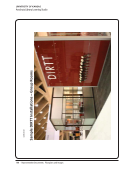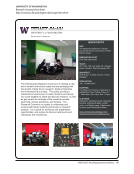48 · Survey Results: Survey Questions and Responses
Our previous service model was costing us approximately $2000 a week in staff time. By moving the service to a new
location and using existing staff, we were able to reallocate that staff time for other activities and use existing service
points distributed across the libraries to provide a high level of service to digital reference users.
Student input and need helped drive this service reconfiguration.
The fact that these collections were shrinking, could be downsized, or could be stored more efficiently helped to make
this merger do-able. The volume of hard-copy course reserve has shrunk steadily through the years, as e-reserve grows
in importance. We have been steadily weeding our microfilm collection as more material becomes available digitally
(keeping in mind, of course, the importance of microfilm from a preservation perspective, for truly archival collections).
We are able to store our growing media collection (CDs, DVDs) on compact shelving.
The service point was on the opposite side of a large lobby from the unit that supervised the students staffing the desk.
This made it difficult for the student supervisor to monitor performance at the desk.
The service reconfigurations were driven by our commitment to meet the needs of our students and faculty by providing
technology rich, collaborative spaces where informal learning is enabled. We have partnered with colleagues in the
Graduate School and Undergraduate Academic Affairs among others to deliver programs and services in these spaces
with the goal of fostering interdisciplinary connections.
This change was driven by a change in focus of the school to research and scholarship, by financial issues resulting
from the economic meltdown, by the opportunity for greater collaboration between the school and the library, and by
advancing technology.
Example 1: User Participation
14. Did your library involve users in the planning, implementation, and/or assessment of this service
reconfiguration? Please select one answer in each row. N=50
Yes No
Planning 28 22
Implementation 10 39
Assessment 29 19
Respondents 35 40
If you answered “Yes”, please briefly describe the methods that were used to engage users.
Planning Process
But only by virtue of counted numbers in decline.
Consulted informally with patrons.
Design charrette focus groups surveys Graduate and Professional Student Advisory Committee.
Our previous service model was costing us approximately $2000 a week in staff time. By moving the service to a new
location and using existing staff, we were able to reallocate that staff time for other activities and use existing service
points distributed across the libraries to provide a high level of service to digital reference users.
Student input and need helped drive this service reconfiguration.
The fact that these collections were shrinking, could be downsized, or could be stored more efficiently helped to make
this merger do-able. The volume of hard-copy course reserve has shrunk steadily through the years, as e-reserve grows
in importance. We have been steadily weeding our microfilm collection as more material becomes available digitally
(keeping in mind, of course, the importance of microfilm from a preservation perspective, for truly archival collections).
We are able to store our growing media collection (CDs, DVDs) on compact shelving.
The service point was on the opposite side of a large lobby from the unit that supervised the students staffing the desk.
This made it difficult for the student supervisor to monitor performance at the desk.
The service reconfigurations were driven by our commitment to meet the needs of our students and faculty by providing
technology rich, collaborative spaces where informal learning is enabled. We have partnered with colleagues in the
Graduate School and Undergraduate Academic Affairs among others to deliver programs and services in these spaces
with the goal of fostering interdisciplinary connections.
This change was driven by a change in focus of the school to research and scholarship, by financial issues resulting
from the economic meltdown, by the opportunity for greater collaboration between the school and the library, and by
advancing technology.
Example 1: User Participation
14. Did your library involve users in the planning, implementation, and/or assessment of this service
reconfiguration? Please select one answer in each row. N=50
Yes No
Planning 28 22
Implementation 10 39
Assessment 29 19
Respondents 35 40
If you answered “Yes”, please briefly describe the methods that were used to engage users.
Planning Process
But only by virtue of counted numbers in decline.
Consulted informally with patrons.
Design charrette focus groups surveys Graduate and Professional Student Advisory Committee.






















































































































































































































